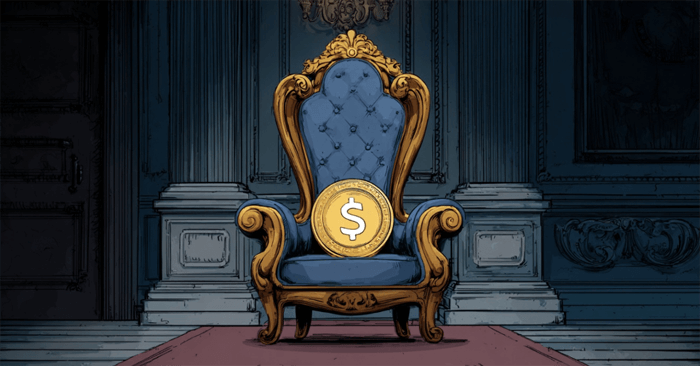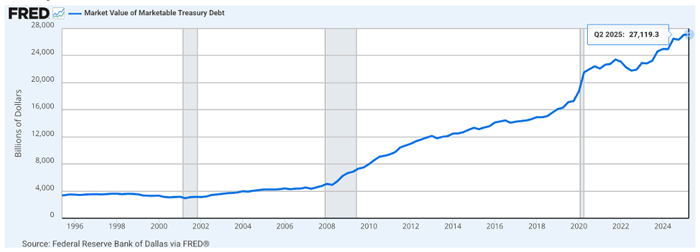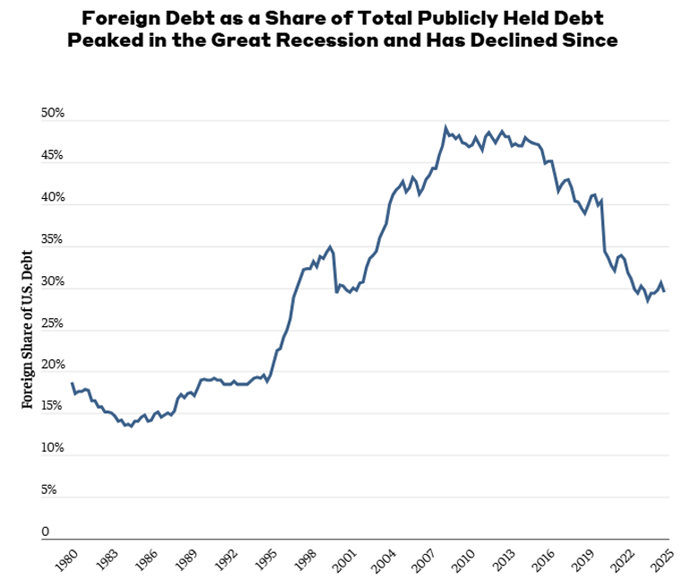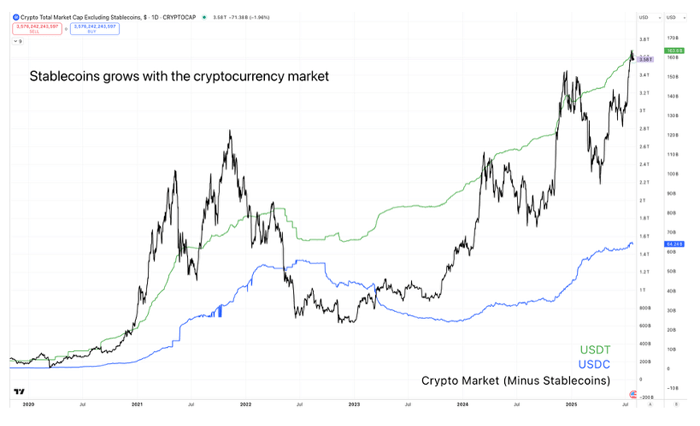
Yesterday, the U.S. Department of the Treasury quietly released a statement that most investors ignored.
Buried in the fine print was a number that tells us everything we need to know about where capital is heading next – and why digital assets are about to catch a fresh tailwind.
That number? $1.007 trillion.
That’s how much the Treasury expects to borrow in the third quarter of 2025 alone.
It will be the second-highest quarterly borrowing total since the COVID panic… and it pushes total U.S. debt issuance to levels that will likely exceed $28 trillion before October.
That’s a $1 trillion jump in a single quarter – a nearly 4% increase in the national debt in just 90 days.

The point here is that Treasury issuance is accelerating. And Treasury Secretary Scott Bessent needs to find more buyers of this debt.
Foreign governments have been unable to keep up their purchases with the increasing debt load. China has divested over $500 billion of U.S. Treasurys over the past 10 years. And even Japan, the biggest holder of U.S. Treasurys, has to occasionally sell some to defend its yen.
Foreigners at one time owned 49% of all outstanding U.S. debt. But that has declined precipitously in the past 10 years.

Source: U.S. Department of the Treasury, collected by the Federal Reserve Bank of St. Louis
That leads us to what’s happening in Washington, D.C. In an effort to develop new buyers for the increasing amount of Treasurys, the Trump administration has unleashed a flurry of policies, giving tailwinds to digital assets.
The administration’s legislation paves the way for regulatory certainty on digital assets. It looks to get voted into law at the end of August. Meanwhile, a White House report on digital assets is getting unveiled tomorrow. And Treasury Secretary Bessent is touting how the U.S. will become a leader in the digital asset industry.
All talking points lead us to helping the Treasury find buyers…
Some of this has to do with the passage of the GENIUS Act. President Trump signed this piece of legislation on July 18. It gives regulatory clarity on U.S. dollar stablecoins, which are cryptocurrency assets pegged to the U.S. dollar. They retain their peg by holding short-term U.S. Treasurys and cash as backing.
The legislation was historic. It was the U.S. government’s first meaningful act of clarity for digital assets.
Treasury Secretary Bessent, in light of the signing, remarked, “This groundbreaking technology will buttress the dollar’s status as the global reserve currency, expand access to the dollar economy for billions across the globe, and lead to a surge in demand for US Treasuries, which back stablecoins.”
These comments make it clear what the Treasury has in mind… sourcing more demand for U.S. Treasurys.
That begs the question: How will the administration spark demand for more stablecoin usage?
Take a look at the chart below. It shows the total market cap of cryptocurrencies, excluding stablecoins. That’s the black line.

When the market cap rises, we can see that the green and blue lines tend to rise along with it. These are the total amounts of stablecoins in circulation from the two biggest issuers in the market – Tether and Circle.
So when the cryptocurrency market rises, more stablecoins get created.
These policies have sent the cryptocurrency market on a tear.
Over the last month, Ethereum’s native token, ether, has risen more than 60%, while the rest of the market cap of crypto has gone up 20%.
We can expect that eventually, many sellers of these cryptocurrencies will park their profits in stablecoins. And as more stablecoins get created, more U.S. Treasurys are demanded by the sector.
This is a clue to the playbook.
The White House has been a major proponent of the digital asset industry. In the first few weeks of President Trump’s term, he made sweeping changes.
He created a Crypto Czar position and brought in tech founder and investor David Sacks, assigned Bo Hines to be his adviser on digital assets, got Paul Atkins to lead the Securities and Exchange Commission (SEC), nominated Brian Quintenz to serve as chair of Commodity Futures Trading Commission (CFTC), and got new chairmen to lead the four most important committees relating to finance and digital assets in Congress.
Even the U.S. Treasury brought in a digital asset adviser.
It was a concerted effort to establish pro-crypto positions in the most important pillars of power in Washington, D.C.
The goal is to fulfill Trump’s mission to make the U.S. the “crypto capital of the world.” It’s a complete embrace of the digital asset industry. And from the chart above, it becomes clear why there’s such a desire for the industry to thrive.
And the catalysts are just around the corner…
The CLARITY Act is a piece of legislation that will provide a framework for the industry. It’s the most important piece of legislation that the administration intends to get signed into law.
Its passage will mean the protocols, projects, and companies wanting to build on public blockchains will have the clarity on how to do so. This is in stark contrast to what took place a year ago. Politicians were platforming on anti-crypto agendas, keeping crypto out of the financial system via Operation Chokepoint 2.0, and locking up developers for building new tools (Roman Storm via Tornado Cash).
It’s been a 180-degree turn in sentiment. And it’s part of why the industry is roaring back to life.
Of course, since Ethereum is home to the largest number of stablecoins, it’s clear why ether is outpacing the pack.
The stablecoin narrative is real. In the months ahead, we can expect major tailwinds to support the cryptocurrency space. The industry is garnering lots of media attention along with favorable support from Washington, D.C.
The CLARITY Act is anticipated to go to the Senate for a vote at the end of August. It’s expected to pass and move to the President’s desk quickly after.
But I don’t expect the market to wait around.
If the U.S. Treasury wants to find more buyers, it has a vested interest in seeing the market continue to accelerate. And the protocols that can bring new use cases to the market (that involve stablecoins) are poised to benefit.
This is one of the most exciting times for cryptocurrencies in the decade I’ve been involved. It has all the support needed to bring the internet of finance to everybody.
It’s a mission that lines up with Bessent and Trump’s desire to further the role of the U.S. dollar globally.
Bessent believes that the stablecoin market can grow to be $3.7 trillion – more than 10x higher than the current market cap of $260 billion. That $3.4 trillion will likely flow into Treasurys – and will fill the gap in buyers.
That will keep interest rates low, which will be good for the U.S. economy, businesses, and our investments.
Your Pulse on Crypto,
Ben Lilly
P.S. There are thousands of cryptocurrencies trading today. But Jeff has zeroed in on a small handful for a specific reason: They’re connected to the stablecoin market.
As I mentioned above, the president has recently signed key stablecoin legislation. It’s expected to pave the way for this corner of the market to see up to $3.7 trillion… beginning immediately.
That’s 10 times more than it’s worth today.
Already, small plays have soared 4x, 6x, and even 7x.
But if you want the chance at the biggest gains, you need to act fast.
To help you get started, Jeff put together an urgent broadcast.
He unveils President Trump’s role in this plan… the name of a play that could soar… a special offer for his cryptocurrency research service… and more.
Just click here for all the details.
The Bleeding Edge is the only free newsletter that delivers daily insights and information from the high-tech world as well as topics and trends relevant to investments.
The Bleeding Edge is the only free newsletter that delivers daily insights and information from the high-tech world as well as topics and trends relevant to investments.